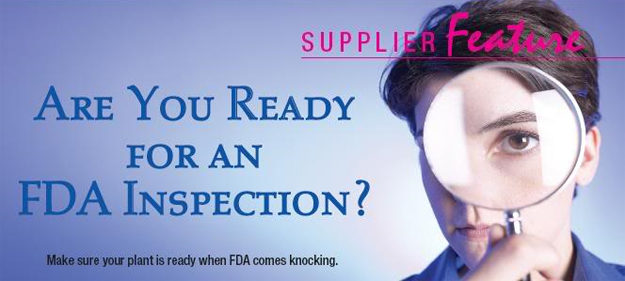It’s 3:00 on a Friday afternoon and most of the key management is off-site at a meeting. A uniformed (and unexpected) team of people enters the lobby and introduces themselves to the receptionist as U.S. Food and Drug Administration (FDA) officials, here to conduct an inspection.
Would your staff know what to do if this happened at your plant?
The Plan
With the recent passing of the dietary supplements good manufacturing practices (GMPs), industry manufacturers must comply with specific regulations that ensure product quality and consistency. Compliance deadlines are approaching for medium-size manufacturers (less than 500 employees), making them potential candidates for an FDA audit. “When FDA arrives at your door, your world changes for the period of time that they are in your building,” said Carl Reynolds, vice president of EAS Consulting Group, LLC, at a recent Food Drug and Law Institute (FDLI) conference. An FDA inspection is intimidating, but it can be less scary if you prepare in advance.
First, know the law and establish GMP-compliant standard operating procedures (SOPs) for all manufacturing processes—including what to do in the event of an FDA inspection. Stated James J. Cudahy, president and COO of Sabinsa Corporation (who also spoke at the FDLI seminar), “Minimizing variation is key. Making procedures, writing them down, educating employees on them and ensuring they follow them will avoid variation.” The goal should never be to deviate from your established SOPs; and if you need to alter them, follow a proper change-control system and keep records of all changes.
ONLINE EXCLUSIVE
|
Reynolds warned against buying boilerplate SOPs from third-party sources. “Those SOPs do not address the regs,” he stated. “They don’t say how you are going to comply with the reg such as how are you going to demonstrate that your water meets EPA standards.”
Next, train all your staff on what it means to be FDA compliant, what are your established SOPs, and what to do if inspectors come. “The entire organization needs to understand what’s going on, including those out on the floor. That’s key,” says Cudahy, who suggests not presenting the information as “how to pass an audit.” Rather, make the reason that if all employees as a team follow GMPs, they will contribute to an improved final product and process. “This mindset is key for both evolving organizations and those starting from scratch,” he explains. As an added bonus, it will help ensure your staff members take pride in ensuring quality and follow the guidelines 365 days per year.
In addition, be sure to establish a team (with backup members in the event of absences) that is assigned to coordinate with inspectors. The group should be lead by a point person and each person should be responsible for fielding certain questions from FDA (i.e., Joe Brown answers questions about X and Mary Smith responds to queries on Y). It goes without saying that team members should have diverse specialties. After all, ensuring GMP compliance isn’t just the responsibility of the quality assurance department; many members of your staff play important roles when your site is audited. For example, a receptionist can be trained to ask FDA officials for identification, sign them in, escort the team to a conference room and alert the appropriate team members that are responsible for coordinating with FDA inspectors.
One thing to keep in mind is that FDA has the right to enter your site at any time (within reasonable limits). Says Reynolds, “The agency considers ‘reasonable’ any time you are in operation. If you operate 24/7, then FDA is entitled to come in during that time…even if it’s 3:00 in the morning.” Therefore, be sure to train team members from all shifts to deal with FDA inspectors because you never know when the FDA may inspect your facility. “In the food arena, FDA does not normally pre-notify you of their intent to inspect,” says Reynolds who adds, “You cannot refuse the inspection if it is done in a reasonable manner.”
Clearly, preparation is the “key word here,” says Cudahy. “A lot of work needs to be done up-front before an auditor arrives.”
Record Keeping
If an FDA inspector with a microbiology background asks a round of data-intensive questions, don’t do yourself the disservice of neglecting your record keeping. Also, be sure to train appropriate staff members on how and where to access them. FDA requires that product records be readily available if FDA inspectors need to see them. In fact, if you can’t produce the records, the product could be considered adulterated. “If you haven’t developed an internal procedure for how to address this during the inspection, you might be well to do so…this is a big deal,” advises Reynolds. Another tip to remember: if you have electronic records they must be viewable on-site. For example, if old records were stored on microfiche, you must have an appropriate reader available.
Gap Analysis
When in doubt about whether your facility is up to code, know that you have many tools at your disposal. Industry associations frequently offer seminars and training for becoming GMP compliant. If you’re trying to determine if there are any holes in your procedures or how you can improve them, consider hiring a third-party to do a mock audit. And, make sure they have similar experience to what you need. Don’t hesitate to contact your local FDA office; they give free voluntary compliance audits and offer good suggestions for improvement. WF
Published in WholeFoods Magazine, April 2009










